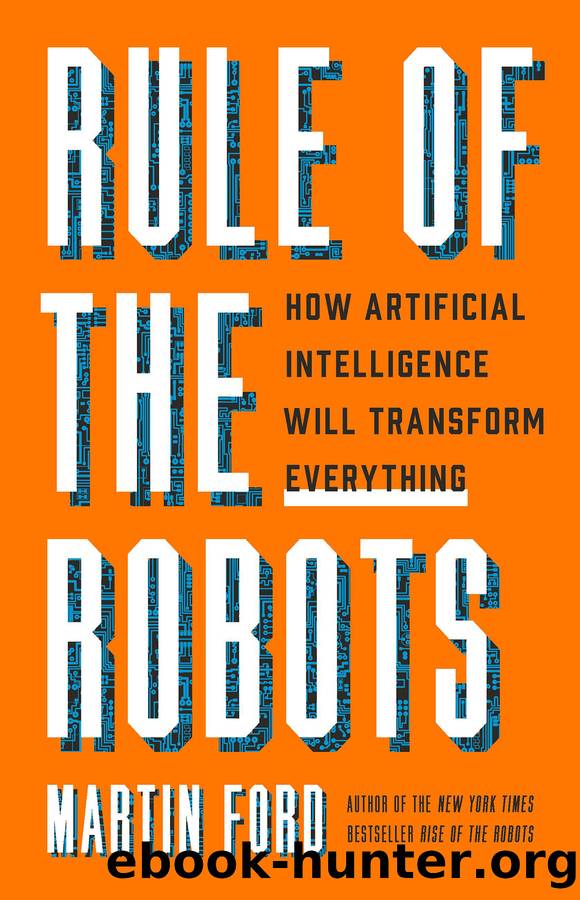Rule of the Robots: How Artificial Intelligence Will Transform Everything by Martin Ford

Author:Martin Ford [Ford, Martin]
Language: eng
Format: epub
ISBN: 9781541674721
Google: 6zsXEAAAQBAJ
Publisher: Hachette UK
Published: 2021-09-13T23:00:00+00:00
Unsupervised Learning
As weâve seen, the two primary techniques used to train deep learning systems are supervised learning, which requires large quantities of labeled data, and reinforcement learning, which requires a huge number of trial-and-error iterations as an algorithm attempts to succeed at a task. Though human beings likewise employ these techniques, they constitute only a tiny fraction of the learning that goes on in a young childâs mind. Very young children learn from simple observation, by listening to the voices of their parents and by engaging and experimenting directly with the world around them.
Newly born babies begin the process almost immediately, learning directly from their environment long before they have the physical ability to interact with it in any deliberate way. Somehow, they manage to develop a physical model of the world and begin to build the base of knowledge that underlies common sense. This ability to learn directly and without assistance from structured and labeled data is known as âunsupervised learning.â This remarkable ability may well be enabled by some kind of cognitive structure built into the childâs brain, but there is no doubt that the ability of a human child to learn independently, and especially to acquire language, vastly outpaces anything that can be accomplished with the most powerful deep learning system.
This early unsupervised learning then supports more advanced knowledge acquisition later on. Even when an older childâs learning is to some extent supervised, the training data required is a tiny fraction of what would need to be provided to even the most advanced algorithm. A deep neural network might require many thousands of labeled training photographs before it can reliably attach the names of animals to their images. In contrast, a parent pointing to an animal and saying, âThis is a dogâ a single time might well be sufficient. And once the child can identify the animal, she can likely do so in any configuration; the dog could be sitting or standing or running across the road, and still the child can consistently attach a name to it.
Unsupervised learning is currently one of the hottest research topics in the field of artificial intelligence. Google, Facebook and DeepMind all have teams focused in this area. Progress, however, has been slow, and few if any truly practical applications have so far emerged. The truth is that no one really has any idea exactly how the human brain achieves its unparalleled competence at autonomously learning from unstructured data. Most current research is focused on less ambitious-sounding variants of unsupervised learning, such as predictive learning or self-supervised learning. Example projects might include trying to predict the next word in a sentence or the image that makes up the next frame in a video. While these kinds of tasks may seem a far cry from what humans manage, many researchers believe that the ability to make predictions is absolutely central to intelligence and that experiments like these will drive things in the right direction. Itâs difficult to overstate the magnitude of a genuine breakthrough in unsupervised machine learning.
Download
This site does not store any files on its server. We only index and link to content provided by other sites. Please contact the content providers to delete copyright contents if any and email us, we'll remove relevant links or contents immediately.
Algorithms of the Intelligent Web by Haralambos Marmanis;Dmitry Babenko(8298)
Test-Driven Development with Java by Alan Mellor(6716)
Data Augmentation with Python by Duc Haba(6629)
Principles of Data Fabric by Sonia Mezzetta(6379)
Learn Blender Simulations the Right Way by Stephen Pearson(6275)
Microservices with Spring Boot 3 and Spring Cloud by Magnus Larsson(6148)
Hadoop in Practice by Alex Holmes(5958)
Jquery UI in Action : Master the concepts Of Jquery UI: A Step By Step Approach by ANMOL GOYAL(5806)
RPA Solution Architect's Handbook by Sachin Sahgal(5543)
Big Data Analysis with Python by Ivan Marin(5361)
The Infinite Retina by Robert Scoble Irena Cronin(5237)
Life 3.0: Being Human in the Age of Artificial Intelligence by Tegmark Max(5144)
Pretrain Vision and Large Language Models in Python by Emily Webber(4322)
Infrastructure as Code for Beginners by Russ McKendrick(4081)
Functional Programming in JavaScript by Mantyla Dan(4038)
The Age of Surveillance Capitalism by Shoshana Zuboff(3948)
WordPress Plugin Development Cookbook by Yannick Lefebvre(3797)
Embracing Microservices Design by Ovais Mehboob Ahmed Khan Nabil Siddiqui and Timothy Oleson(3601)
Applied Machine Learning for Healthcare and Life Sciences Using AWS by Ujjwal Ratan(3573)
